wheel Lexus GS350 2011 Manual PDF
[x] Cancel search | Manufacturer: LEXUS, Model Year: 2011, Model line: GS350, Model: Lexus GS350 2011Pages: 654, PDF Size: 11.03 MB
Page 473 of 654
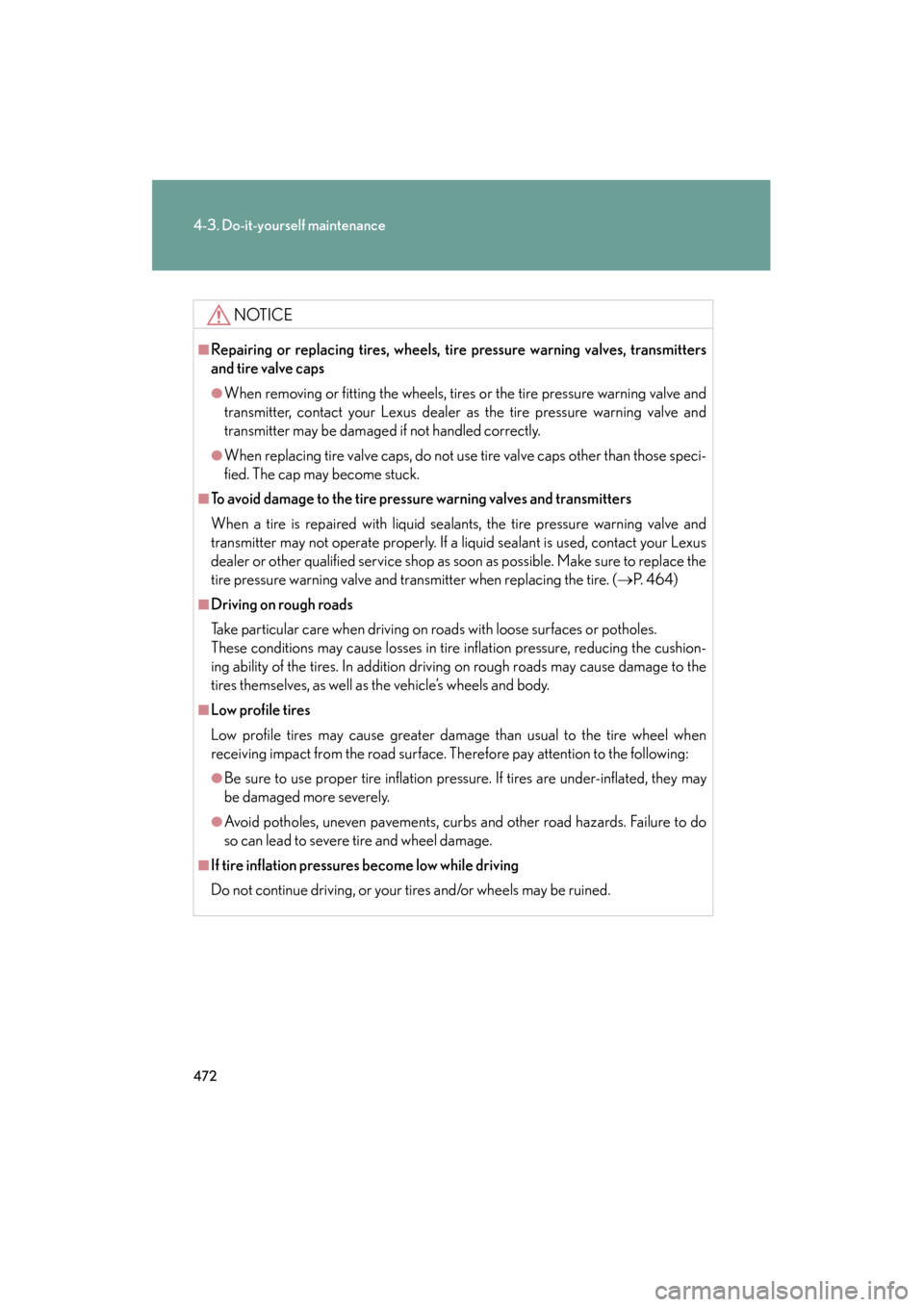
472
4-3. Do-it-yourself maintenance
GS_G_U (OM30C11U)
October 28, 2011 5:15 pm
NOTICE
■Repairing or replacing tires, wheels, tire pressure warning valves, transmitters
and tire valve caps
●When removing or fitting the wheels, tires or the tire pressure warning valve and
transmitter, contact your Lexus dealer as the tire pressure warning valve and
transmitter may be damaged if not handled correctly.
●When replacing tire valve caps, do not use tire valve caps other than those speci-
fied. The cap may become stuck.
■To avoid damage to the tire pressu re warning valves and transmitters
When a tire is repaired with liquid sealants, the tire pressure warning valve and
transmitter may not operate properly. If a liquid sealant is used, contact your Lexus
dealer or other qualified service shop as soon as possible. Make sure to replace the
tire pressure warning valve and transmitter when replacing the tire. ( →P. 4 6 4 )
■Driving on rough roads
Take particular care when driving on roads with loose surfaces or potholes.
These conditions may cause losses in tire inflation pressure, reducing the cushion-
ing ability of the tires. In addition driving on rough roads may cause damage to the
tires themselves, as well as the vehicle’s wheels and body.
■Low profile tires
Low profile tires may cause greater damage than usual to the tire wheel when
receiving impact from the road surface. Therefore pay attention to the following:
●Be sure to use proper tire inflation pressure. If tires are under-inflated, they may
be damaged more severely.
●Avoid potholes, uneven pavements, curbs and other road hazards. Failure to do
so can lead to severe tire and wheel damage.
■If tire inflation pressures become low while driving
Do not continue driving, or your tires and/or wheels may be ruined.
Page 477 of 654
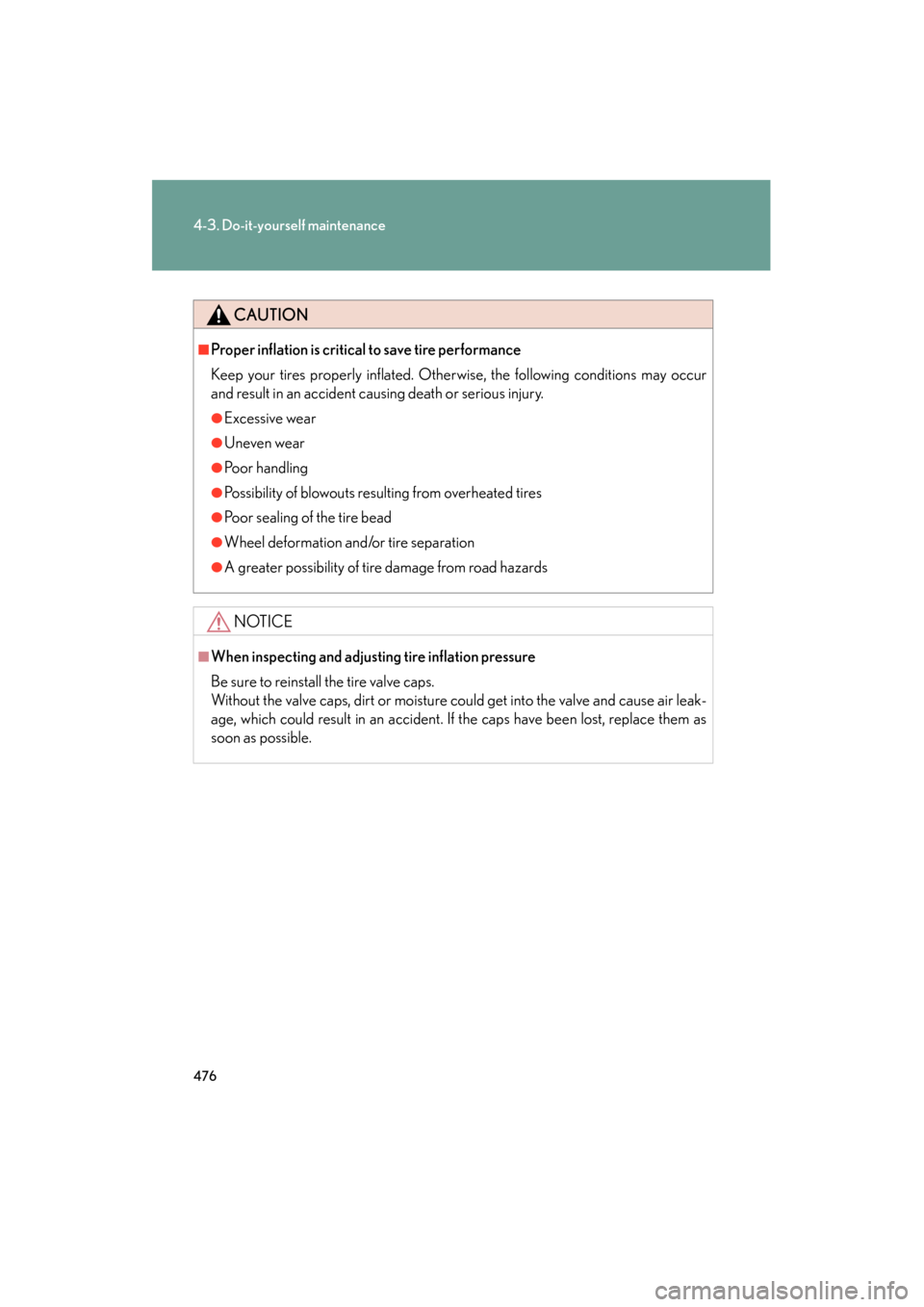
476
4-3. Do-it-yourself maintenance
GS_G_U (OM30C11U)
October 28, 2011 5:15 pm
CAUTION
■Proper inflation is critical to save tire performance
Keep your tires properly inflated. Otherwise, the following conditions may occur
and result in an accident causing death or serious injury.
●Excessive wear
●Uneven wear
●Poor handling
●Possibility of blowouts resulting from overheated tires
●Poor sealing of the tire bead
●Wheel deformation and/or tire separation
●A greater possibility of tire damage from road hazards
NOTICE
■When inspecting and adjusting tire inflation pressure
Be sure to reinstall the tire valve caps.
Without the valve caps, dirt or moisture could get into the valve and cause air leak-
age, which could result in an accident. If the caps have been lost, replace them as
soon as possible.
Page 478 of 654
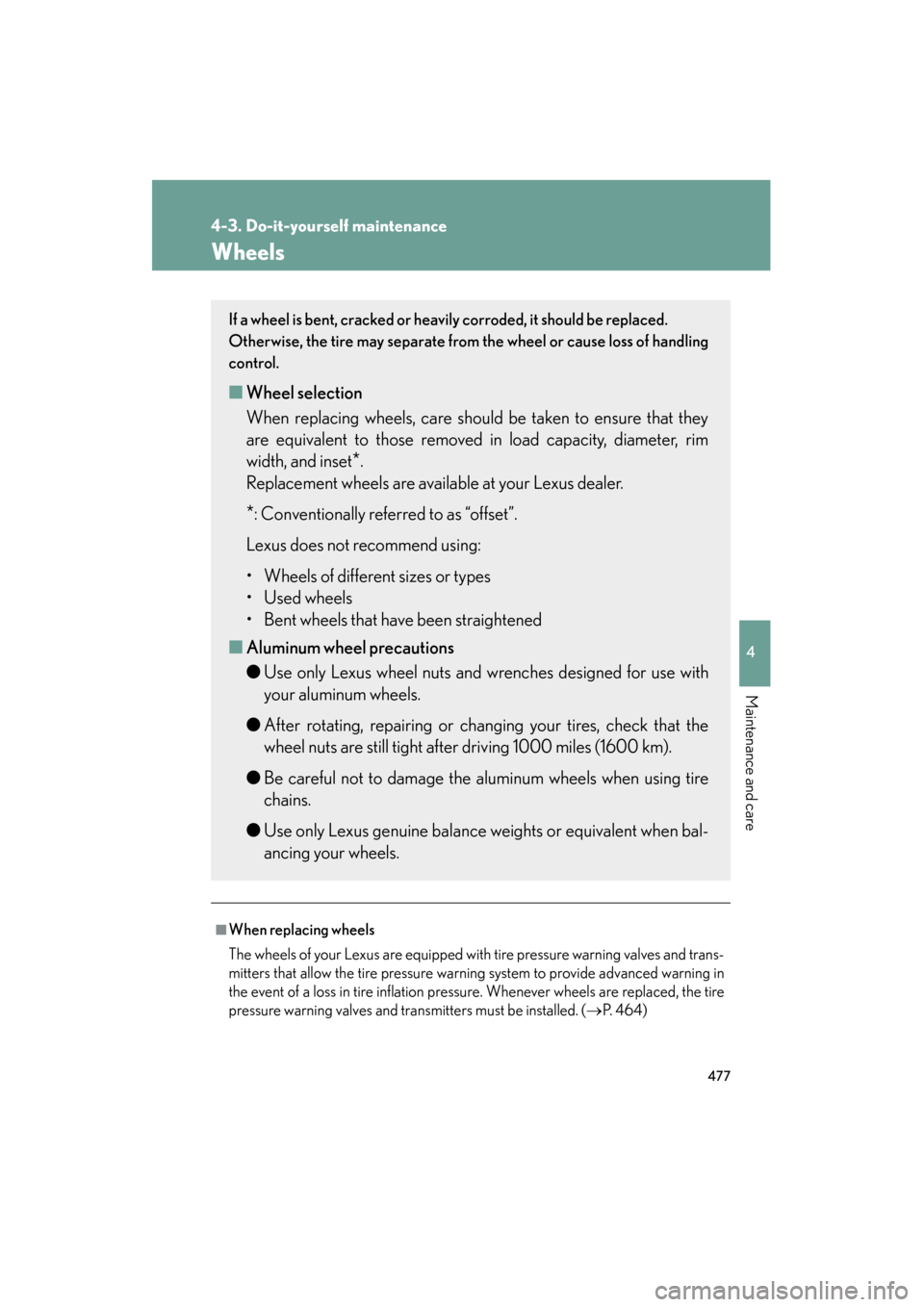
477
4-3. Do-it-yourself maintenance
4
Maintenance and care
GS_G_U (OM30C11U)
October 28, 2011 5:15 pm
Wheels
■When replacing wheels
The wheels of your Lexus are equipped with tire pressure warning valves and trans-
mitters that allow the tire pressure warning system to provide advanced warning in
the event of a loss in tire inflation pressure. Whenever wheels are replaced, the tire
pressure warning valves and transmitters must be installed. (→P. 4 6 4 )
If a wheel is bent, cracked or heavily corroded, it should be replaced.
Otherwise, the tire may separate from the wheel or cause loss of handling
control.
■ Wheel selection
When replacing wheels, care should be taken to ensure that they
are equivalent to those removed in load capacity, diameter, rim
width, and inset
*.
Replacement wheels are available at your Lexus dealer.
*: Conventionally referred to as “offset”.
Lexus does not recommend using:
• Wheels of different sizes or types
• Used wheels
• Bent wheels that have been straightened
■ Aluminum wheel precautions
● Use only Lexus wheel nuts and wrenches designed for use with
your aluminum wheels.
● After rotating, repairing or changing your tires, check that the
wheel nuts are still tight after driving 1000 miles (1600 km).
● Be careful not to damage the aluminum wheels when using tire
chains.
● Use only Lexus genuine balance weights or equivalent when bal-
ancing your wheels.
Page 479 of 654
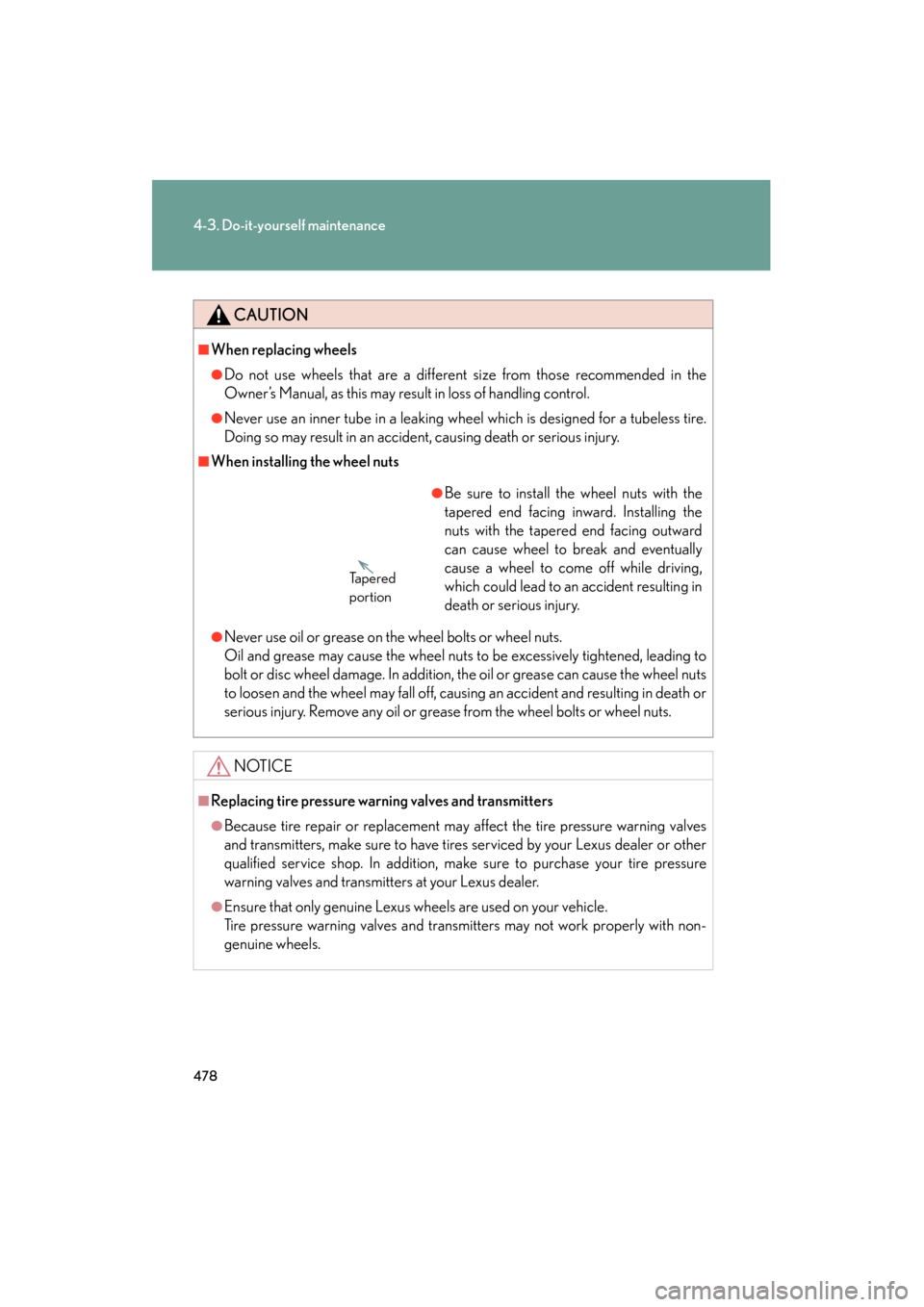
478
4-3. Do-it-yourself maintenance
GS_G_U (OM30C11U)
October 28, 2011 5:15 pm
CAUTION
■When replacing wheels
●Do not use wheels that are a different size from those recommended in the
Owner’s Manual, as this may result in loss of handling control.
●Never use an inner tube in a leaking wheel which is designed for a tubeless tire.
Doing so may result in an accident, causing death or serious injury.
■When installing the wheel nuts
●Never use oil or grease on the wheel bolts or wheel nuts.
Oil and grease may cause the wheel nuts to be excessively tightened, leading to
bolt or disc wheel damage. In addition, the oil or grease can cause the wheel nuts
to loosen and the wheel may fall off, causing an accident and resulting in death or
serious injury. Remove any oil or grease from the wheel bolts or wheel nuts.
NOTICE
■Replacing tire pressure warning valves and transmitters
●Because tire repair or replacement may affect the tire pressure warning valves
and transmitters, make sure to have tires serviced by your Lexus dealer or other
qualified service shop. In addition, make sure to purchase your tire pressure
warning valves and transmitters at your Lexus dealer.
●Ensure that only genuine Lexus wheels are used on your vehicle.
Tire pressure warning valves and transmitters may not work properly with non-
genuine wheels.
●Be sure to install the wheel nuts with the
tapered end facing inward. Installing the
nuts with the tapered end facing outward
can cause wheel to break and eventually
cause a wheel to come off while driving,
which could lead to an accident resulting in
death or serious injury.
Ta p e r e d
portion
Page 491 of 654
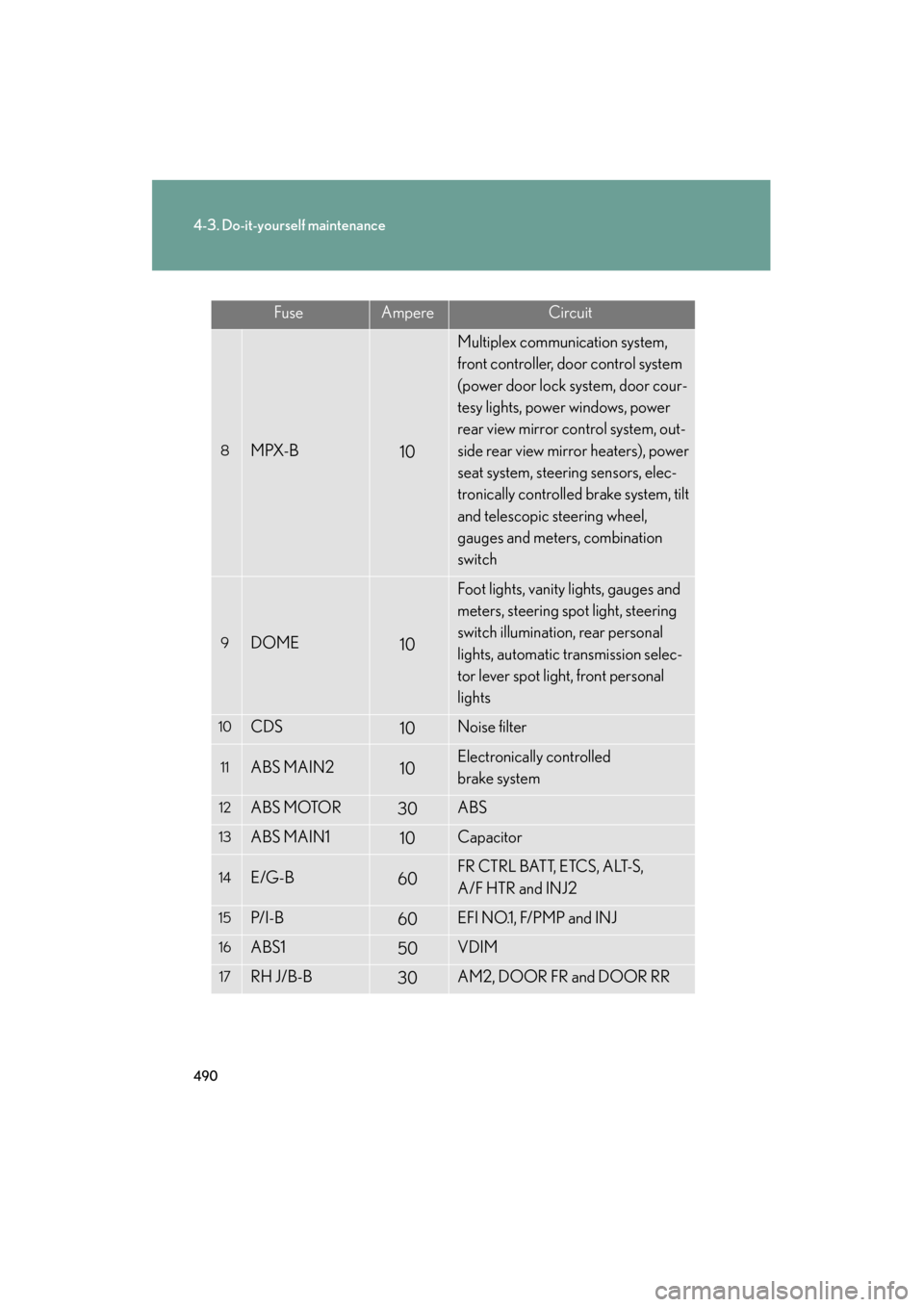
490
4-3. Do-it-yourself maintenance
GS_G_U (OM30C11U)
October 28, 2011 5:15 pm
FuseAmpereCircuit
8MPX-B10
Multiplex communication system,
front controller, door control system
(power door lock system, door cour-
tesy lights, power windows, power
rear view mirror control system, out-
side rear view mirror heaters), power
seat system, steering sensors, elec-
tronically controlled brake system, tilt
and telescopic steering wheel,
gauges and meters, combination
switch
9DOME10
Foot lights, vanity lights, gauges and
meters, steering spot light, steering
switch illumination, rear personal
lights, automatic transmission selec-
tor lever spot light, front personal
lights
10CDS10Noise filter
11ABS MAIN210Electronically controlled
brake system
12ABS MOTOR30ABS
13ABS MAIN110Capacitor
14E/G-B60FR CTRL BATT, ETCS, ALT-S,
A/F HTR and INJ2
15P/ I - B60EFI NO.1, F/PMP and INJ
16ABS150VDIM
17RH J/B-B30AM2, DOOR FR and DOOR RR
Page 494 of 654
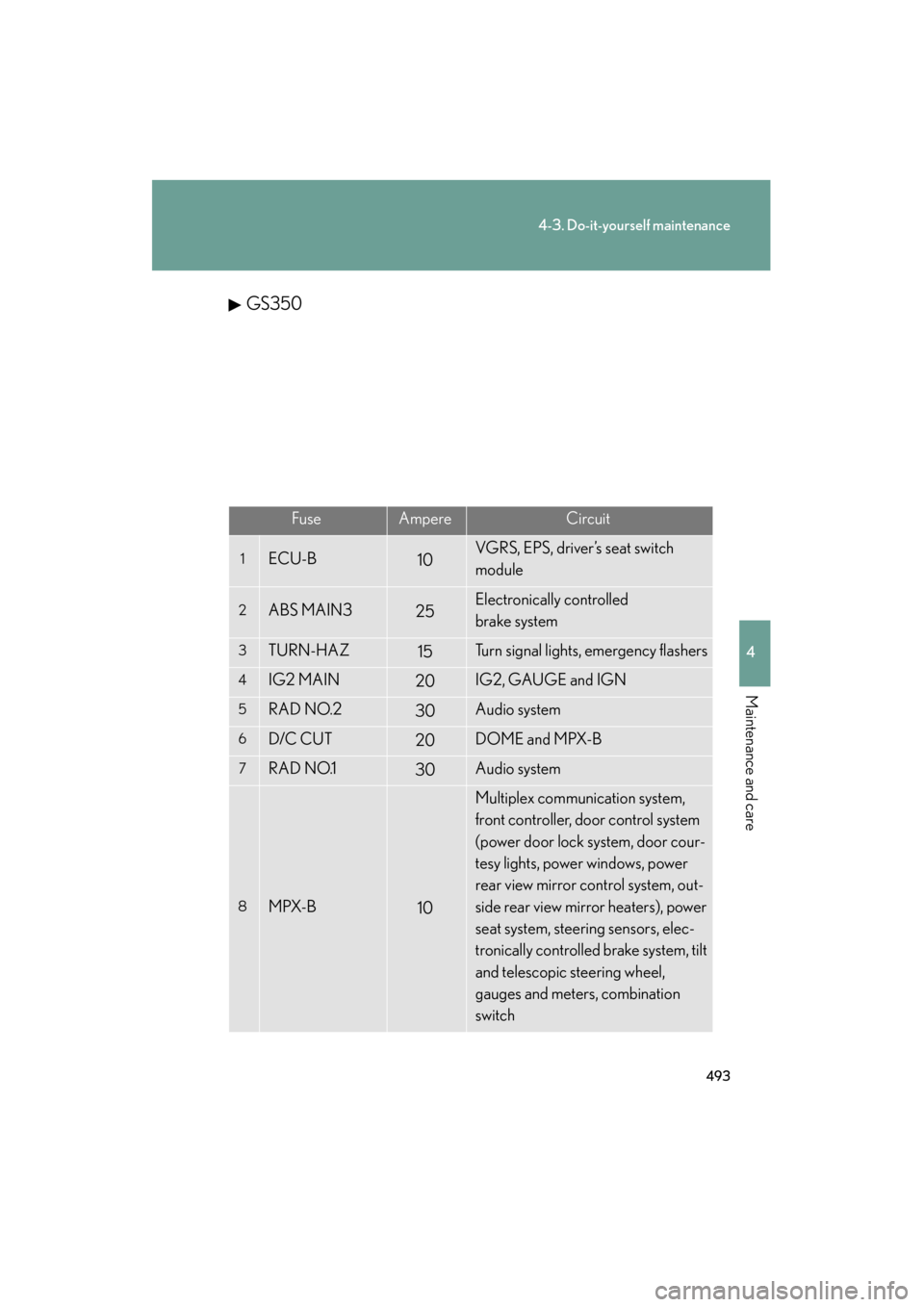
493
4-3. Do-it-yourself maintenance
4
Maintenance and care
GS_G_U (OM30C11U)
October 28, 2011 5:15 pm
GS350
FuseAmpereCircuit
1ECU-B10VGRS, EPS, driver’s seat switch
module
2ABS MAIN325Electronically controlled
brake system
3TURN-HAZ15Turn signal lights, emergency flashers
4IG2 MAIN20IG2, GAUGE and IGN
5RAD NO.230Audio system
6D/C CUT20DOME and MPX-B
7RAD NO.130Audio system
8MPX-B10
Multiplex communication system,
front controller, door control system
(power door lock system, door cour-
tesy lights, power windows, power
rear view mirror control system, out-
side rear view mirror heaters), power
seat system, steering sensors, elec-
tronically controlled brake system, tilt
and telescopic steering wheel,
gauges and meters, combination
switch
Page 502 of 654
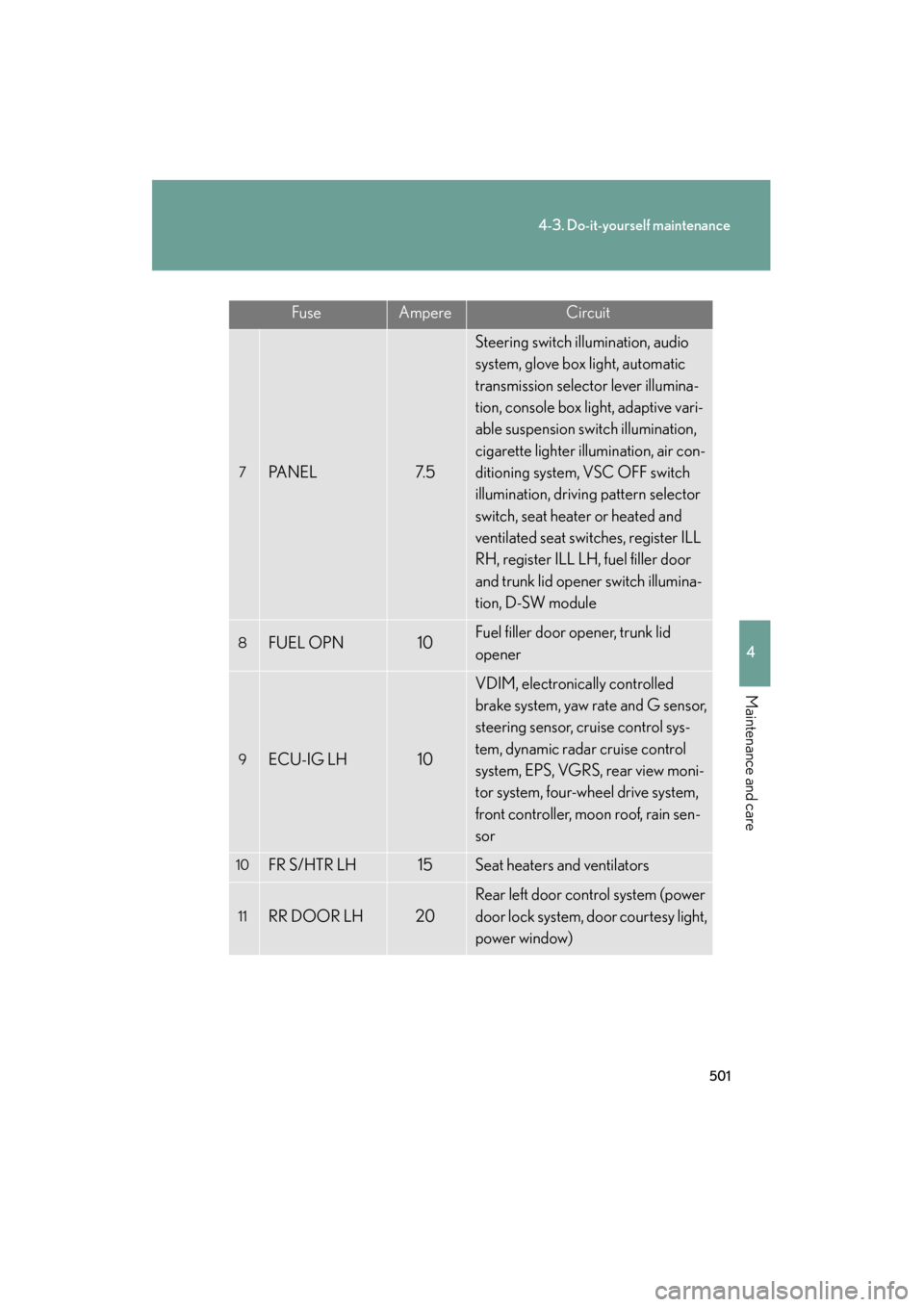
501
4-3. Do-it-yourself maintenance
4
Maintenance and care
GS_G_U (OM30C11U)
October 28, 2011 5:15 pm
FuseAmpereCircuit
7PA N E L7. 5
Steering switch illumination, audio
system, glove box light, automatic
transmission selector lever illumina-
tion, console box light, adaptive vari-
able suspension switch illumination,
cigarette lighter illumination, air con-
ditioning system, VSC OFF switch
illumination, driving pattern selector
switch, seat heater or heated and
ventilated seat switches, register ILL
RH, register ILL LH, fuel filler door
and trunk lid opener switch illumina-
tion, D-SW module
8FUEL OPN10Fuel filler door opener, trunk lid
opener
9ECU-IG LH10
VDIM, electronically controlled
brake system, yaw rate and G sensor,
steering sensor, cruise control sys-
tem, dynamic radar cruise control
system, EPS, VGRS, rear view moni-
tor system, four-wheel drive system,
front controller, moon roof, rain sen-
sor
10FR S/HTR LH15Seat heaters and ventilators
11RR DOOR LH20
Rear left door control system (power
door lock system, door courtesy light,
power window)
Page 504 of 654
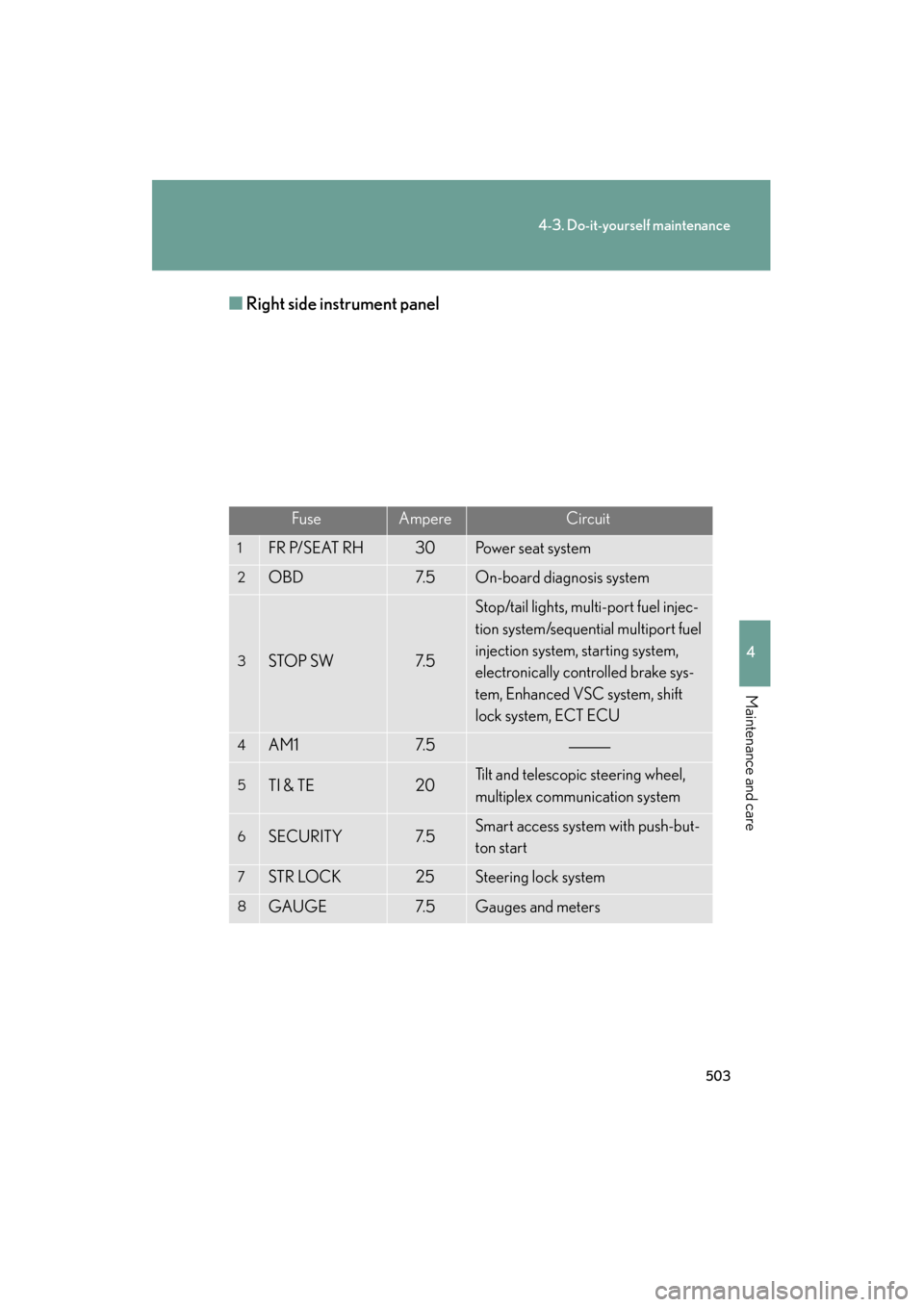
503
4-3. Do-it-yourself maintenance
4
Maintenance and care
GS_G_U (OM30C11U)
October 28, 2011 5:15 pm
■Right side instrument panel
FuseAmpereCircuit
1FR P/SEAT RH30Power seat system
2OBD7. 5On-board diagnosis system
3STOP SW7. 5
Stop/tail lights, multi-port fuel injec-
tion system/sequential multiport fuel
injection system, starting system,
electronically controlled brake sys-
tem, Enhanced VSC system, shift
lock system, ECT ECU
4AM17. 5
5TI & TE20Tilt and telescopic steering wheel,
multiplex communication system
6SECURITY7. 5Smart access system with push-but-
ton start
7STR LOCK25Steering lock system
8GAUGE7. 5Gauges and meters
Page 522 of 654
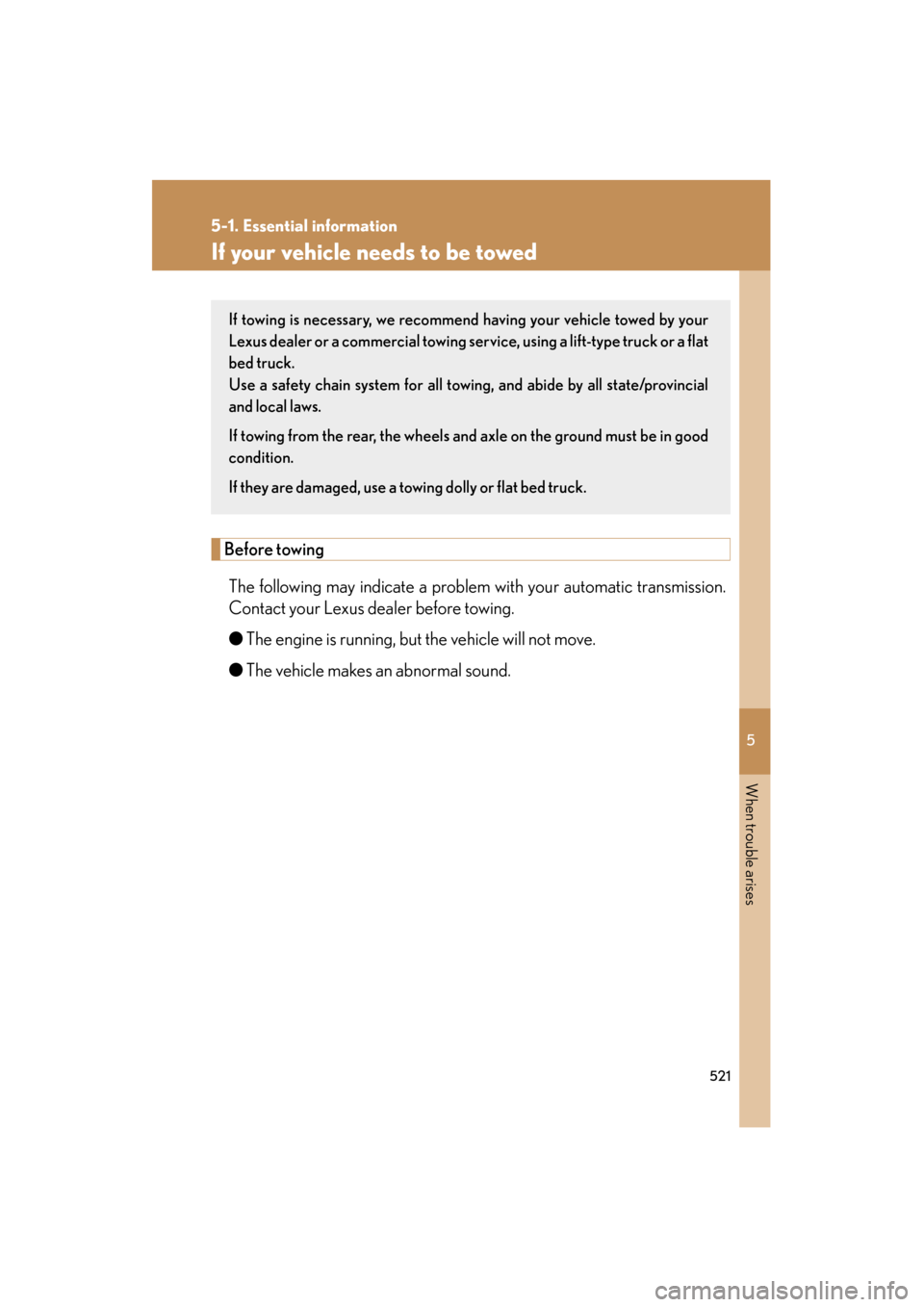
5
When trouble arises
521
5-1. Essential information
GS_G_U (OM30C11U)
October 28, 2011 5:15 pm
If your vehicle needs to be towed
Before towingThe following may indicate a problem with your automatic transmission.
Contact your Lexus dealer before towing.
● The engine is running, but the vehicle will not move.
● The vehicle makes an abnormal sound.
If towing is necessary, we recommend having your vehicle towed by your
Lexus dealer or a commercial towing se rvice, using a lift-type truck or a flat
bed truck.
Use a safety chain system for all towing, and abide by all state/provincial
and local laws.
If towing from the rear, the wheels and axle on the ground must be in good
condition.
If they are damaged, use a towing dolly or flat bed truck.
Page 523 of 654
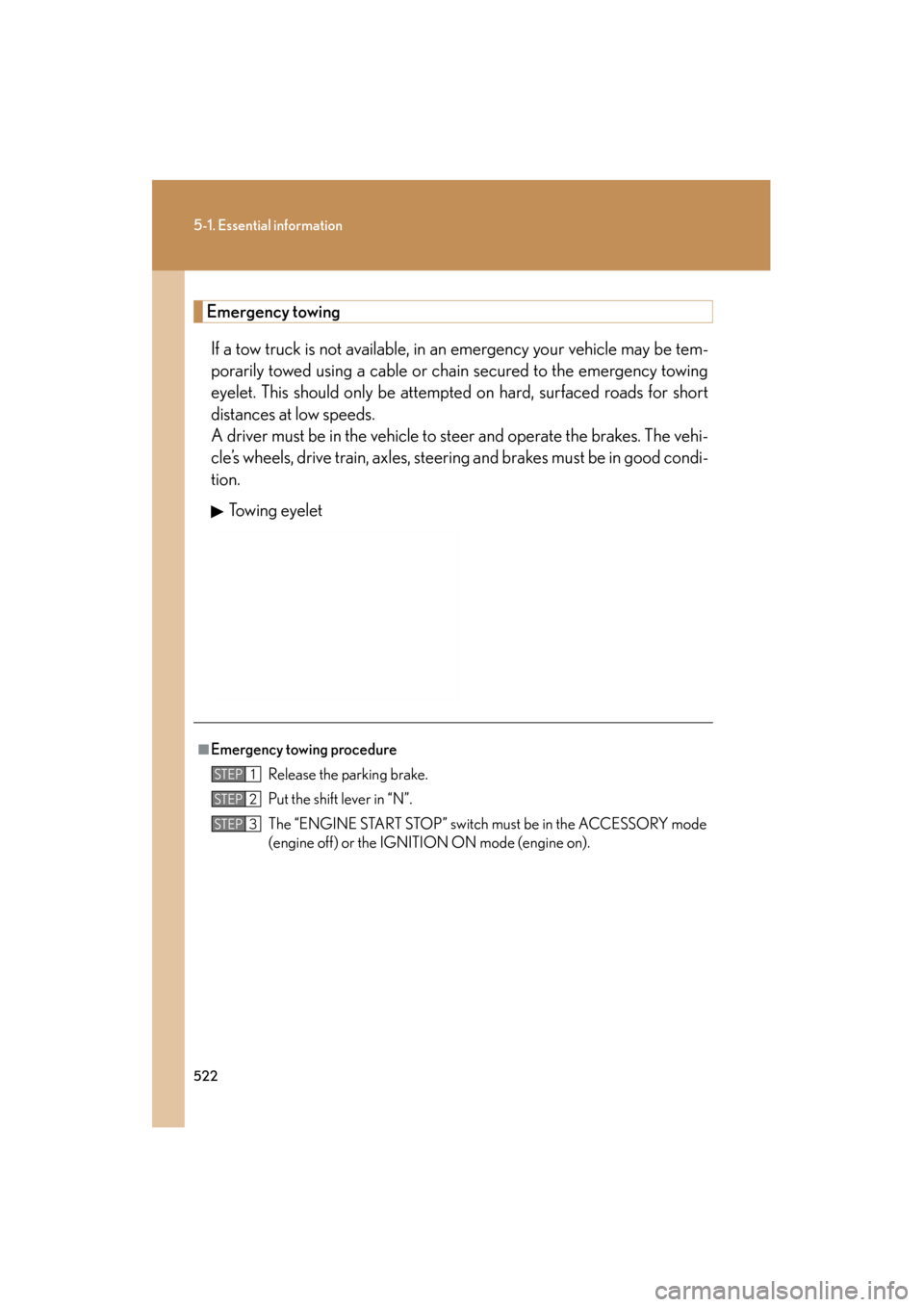
522
5-1. Essential information
GS_G_U (OM30C11U)
October 28, 2011 5:15 pm
Emergency towingIf a tow truck is not available, in an emergency your vehicle may be tem-
porarily towed using a cable or chain secured to the emergency towing
eyelet. This should only be attempted on hard, surfaced roads for short
distances at low speeds.
A driver must be in the vehicle to steer and operate the brakes. The vehi-
cle’s wheels, drive train, axles, steer ing and brakes must be in good condi-
tion.
Towing eyelet
■Emergency towing procedure Release the parking brake.
Put the shift lever in “N”.
The “ENGINE START STOP” switch must be in the ACCESSORY mode
(engine off) or the IGNITION ON mode (engine on).
STEP1
STEP2
STEP3